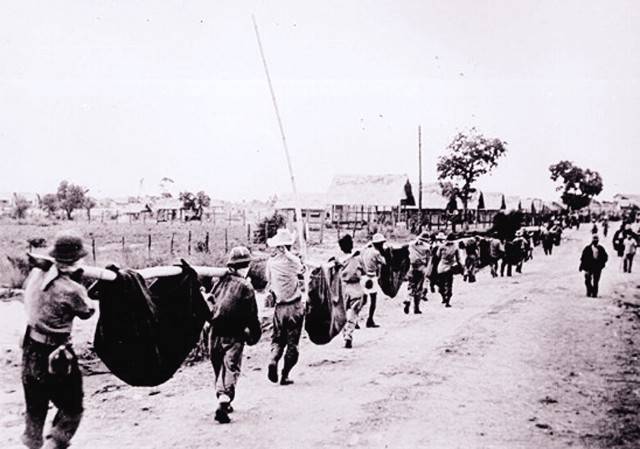
This photograph captures a burial detail of American and Filipino prisoners of war using improvised litters to carry fallen comrades at Camp O’Donnell, Capas, Tarlac, 1942, following the Bataan Death March.
This death march was the forcible transfer by the Imperial Japanese Army of 60,000–80,000 American and Filipino prisoners of war from Saysain Point, Bagac, Bataan and Mariveles to Camp O’Donnell, Capas, Tarlac, via San Fernando, Pampanga, where the prisoners were loaded onto trains. The transfer began on April 9, 1942, after the three-month Battle of Bataan in the Philippines during World War II. The total distance marched from Mariveles to San Fernando and from the Capas Train Station to Camp O’Donnell is variously reported by differing sources as between 60 and 69.6 miles (96 and 112 km). Differing sources also report widely differing prisoner of war casualties prior to reaching Camp O’Donnell: from 5,000 to 18,000 Filipino deaths and 500 to 650 American deaths during the march. The march was characterized by severe physical abuse and wanton killings. After the war, the Japanese commander, General Masaharu Homma and two of his officers were tried in United States military commissions on charges of failing to prevent their subordinates from committing war crimes.

This death march was the forcible transfer by the Imperial Japanese Army of 60,000–80,000 American and Filipino prisoners of war from Saysain Point, Bagac, Bataan and Mariveles to Camp O’Donnell, Capas, Tarlac, via San Fernando, Pampanga, where the prisoners were loaded onto trains. The transfer began on April 9, 1942, after the three-month Battle of Bataan in the Philippines during World War II. The total distance marched from Mariveles to San Fernando and from the Capas Train Station to Camp O’Donnell is variously reported by differing sources as between 60 and 69.6 miles (96 and 112 km). Differing sources also report widely differing prisoner of war casualties prior to reaching Camp O’Donnell: from 5,000 to 18,000 Filipino deaths and 500 to 650 American deaths during the march. The march was characterized by severe physical abuse and wanton killings. After the war, the Japanese commander, General Masaharu Homma and two of his officers were tried in United States military commissions on charges of failing to prevent their subordinates from committing war crimes.


